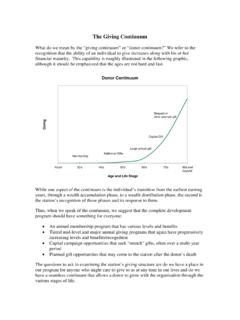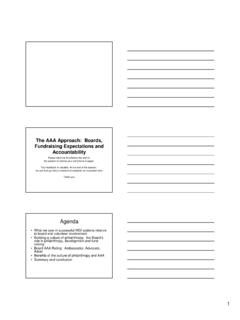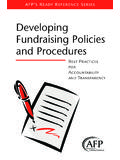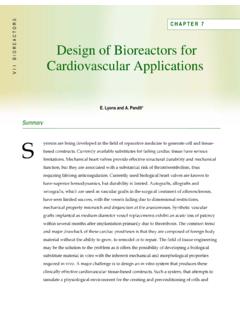Transcription of The Donor Cultivation System - Major Giving Initiative
1 The Donor Cultivation System About this System This is a collection of tools and instructions on how to use them that will take you from identifying donors through cultivating them to getting the gift. There are three principal tools in this System : 1. Prospect ratings tools 2. Moves management tools 3. Prospect call sheets Some of these tools have more than one component. For instance, the moves management tools include a ratings grid for clustering your prospects identifying those with the greatest potential and a spreadsheet for tracking moves.
2 These tools work together as part of a System , and the System is an integral part of this site. Step One: Identifying Prospects How do you start from nothing or at least very little and grow a Major gift program? Start with the connections you already have. You may have a board of directors, you have people who are already Giving to you annually, and you have your viewers/listeners and members. These are the people who will give you more and who will to others who will make gifts of their own. Identify the people who might give to you, suspects.
3 These people live in your community, have a moderate amount of wealth, have an interest in public broadcasting, and know someone who knows you. You will be able to generate a very long list of these people, so long that you will soon need to prioritize it to make your work manageable. Rank these people by a couple different criteria in order to spend your time and energy most effectively. Essentially you need to ask people who are most ready to give to you first. Second, you need to get to better know those who are not quite ready to give to you.
4 And then last, you need to invest the time in developing relationships with people who just don t know you very well. How do you get those who are close to you to tell you who they know? By asking them. Ask them individually; ask them in groups. Prime the list by starting with some obvious names, names you can come up with yourself, prominent people in the community, business people, people who have given to other stations or other non-profits organizations. People seem to have an easier time naming potential donors when they look at a list of possibilities rather than at a blank sheet of paper.
5 You will need to decide whether to undertake this task one-on-one or in a group, it really depends on the personalities and group dynamics. Some people will only share who they The Donor Cultivation System Page 2 know and who they think can give privately. Others need a room full of people shouting out names to really begin to get their own thoughts going. Prospect Attributes You re not looking for just anyone, at least not really. While just about any potential Donor should go on this list, you really want people who have a couple characteristics.
6 1. Wealth. For someone to give you a Major gift, they have to have some wealth. 2. Interest. You want people who have an interest in public whose interest can be developed. 3. Connection. Someone may be wealthy and have an interest in public broadcasting, but have no relationship to you. 4. Charitable intent. Evidence of an inertest in philanthropy is slightly less important. After all, if you ve got the other three characteristics, it s likely that you ll find this fourth. But not always. Wealth Your prospects must be wealthy, but wealth can be hidden.
7 And don t limit yourself to the obvious people in your community who everyone knows are rich. This is the only attribute over which you really have no control. You can build interest and make connections, but you cannot make someone wealthy. How do you tell if someone has wealth? Some of the signs are obvious, some are not: Expensive home, vacation home High-paying job, lucrative profession Owns a business, sold a business Professional, doctor, lawyer, etc. Drives a luxury car, has a boat, airplane Has an expensive hobby like flying or collecting cars Is over 60 years old.
8 Older people have had longer to earn and save money, while younger people usually have many commitments, such as children and college loans. Travels a lot Is retired, even at a young age Younger people who do not work and have no apparent means of earning a living, and yet they live well. People who have inherited wealth the sons/daughters and grandsons/granddaughters of other wealthy people. As discussed elsewhere on this site, there are two kinds of research, informal and formal. For informal research, we have provided two tools. The prospect rating sheet gives you a tool to work with volunteer groups in assessing the interest and capacity of donors .
9 The The Donor Cultivation System Page 3 wealth rating sheet gives you a mix of ways to talk with volunteers about prospect wealth that may be more comfortable for them. For formal research, the Internet has a wealth of information on individuals; it s public, accessible, sometimes free, and yet sometimes not entirely accurate. But it s a great place to augment what you already have. Test some of the pay sites to see if you feel you get value for your money. Note that these websites can change rapidly in content, quality, and location. A good place to start is public real estate records.
10 Tax assessed real estate values are public information everywhere what the county or state says your home is worth and therefore how much tax you owe. Much of this information is free. Beware though that it can be outdated or under- or over-valued. Another note of caution: A solid piece of information indicating the wealth of a potential Donor should only tell you if the prospect is worth pursuing and put you in the general ballpark for Giving levels. It cannot tell you precisely how much to seek. Remember, the information you gather independently will always be incomplete and inconclusive, and how much the prospect will give is largely governed by your Cultivation efforts.








